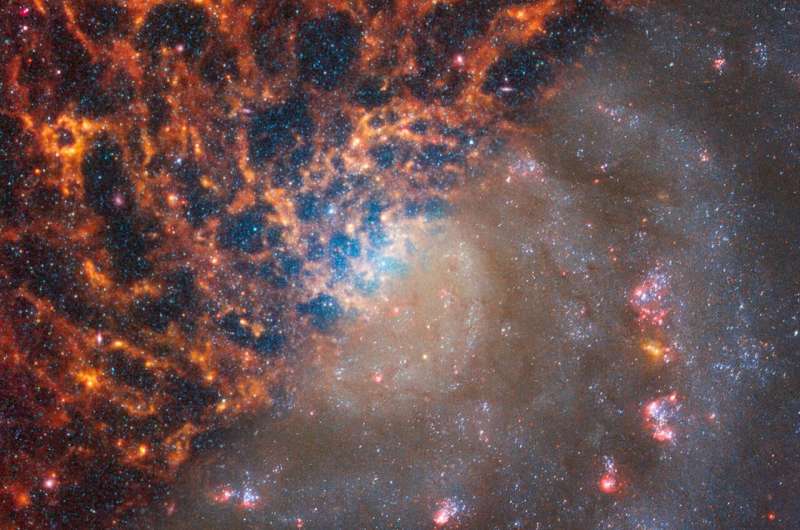This article has been reviewed according to Science X's editorial process and policies. Editors have highlighted the following attributes while ensuring the content's credibility:
fact-checked
trusted source
proofread
NASA's Roman team selects survey to map our galaxy's far side

NASA's Nancy Grace Roman Space Telescope team has announced plans for an unprecedented survey of the plane of our Milky Way galaxy. It will peer deeper into this region than any other survey, mapping more of our galaxy's stars than all previous observations combined.
"There's a really broad range of science we can explore with this type of survey, from star formation and evolution to dust in between stars and the dynamics of the heart of the galaxy," said Catherine Zucker, an astrophysicist at the Center for Astrophysics | Harvard & Smithsonian in Cambridge, Massachusetts, who co-authored a white paper describing some of the benefits of such an observing program.
A galactic plane survey was the top-ranked submission following a 2021 call for Roman survey ideas. Now, the scientific community will work together to design the observational program ahead of Roman's launch by May 2027.
"There will be lots of trade-offs since scientists will have to choose between, for example, how much area to cover and how completely to map it in all the different possible filters," said paper co-author Robert Benjamin, an astronomer at the University of Wisconsin-Whitewater.
While the details of the survey remain to be determined, scientists say if it covered about 1,000 square degrees—a region of sky as large as 5,000 full moons—it could reveal well over 100 billion cosmic objects (mainly stars).
"That would be pretty close to a complete census of all the stars in our galaxy, and it would only take around a month," said Roberta Paladini, a senior research scientist at Caltech/IPAC in Pasadena, California, and the white paper's lead author. "It would take decades to observe such a large patch of the sky with the Hubble or James Webb space telescopes. Roman will be a survey machine."
Milky Way anatomy
Observatories with smaller views of space have provided exquisite images of other galaxies, revealing complex structures. But studying our own galaxy's anatomy is surprisingly difficult. The plane of the Milky Way covers such a large area on the sky that studying it in detail can take a very long time. Astronomers also must peer through thick dust that obscures distant starlight.
While we've studied our solar system's neighborhood well, Zucker says, "We have a very incomplete view of what the other half of that Milky Way looks like beyond the galactic center."
Observatories like NASA's retired Spitzer Space Telescope have conducted large-area surveys of the galactic plane in longer wavelengths of light and revealed some star-forming regions on the far side of the galaxy. But it couldn't resolve fine details like Roman will do.
"Spitzer set up the questions that Roman will be able to solve," Benjamin said.
Roman's combination of a large field of view, crisp resolution, and the ability to peer through dust make it the ideal instrument to study the Milky Way. And seeing stars in different wavelengths of light—optical and infrared—will help astronomers learn things such as the stars' temperatures. That one piece of information unlocks much more data, from the star's evolutionary stage and composition to its luminosity and size.

"We can do very detailed studies of things like star formation and the structure of our own galaxy in a way that we can't do for any other galaxy," Paladini said.
Roman will offer new insights about the structure of the central region known as the bulge, the "bar" that stretches across it, and the spiral arms that extend from it.
"We'll basically rewrite the 3D picture of the far side of the galaxy," Zucker said.
Roman's sharp vision will help astronomers see individual stars even in stellar nurseries on the far side of the galaxy. That will help Roman generate a huge new catalog of stars since it will be able to map 10 times farther than previous precision mapping by ESA's (the European Space Agency's) Gaia space mission.
Gaia mapped over 1 billion stars in 3D, largely within about 10,000 light-years. Roman could map up to 100 billion stars 100,000 light-years away or more (stretching out to the most distant edge of our galaxy and beyond).
The Galactic Plane Survey is Roman's first announced general astrophysics survey—one of several observation programs Roman will do in addition to its three core community surveys and Coronagraph technology demonstration.
At least 25% of Roman's five-year primary mission will be allocated to general astrophysics surveys in order to pursue science that can't be done with only the mission's core community survey data. Astronomers from all over the world will have the opportunity to use Roman and propose cutting-edge research, enabling the astronomical community to utilize the full potential of Roman's capabilities to conduct extraordinary science.
The work is published on the arXiv preprint server.
More information: Roberta Paladini et al, Roman Early-Definition Astrophysics Survey Opportunity: Galactic Roman Infrared Plane Survey (GRIPS), arXiv (2023). DOI: 10.48550/arxiv.2307.07642
Provided by NASA





















